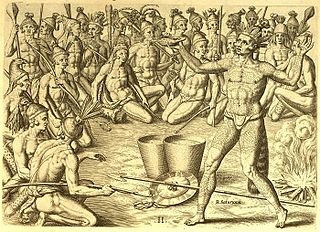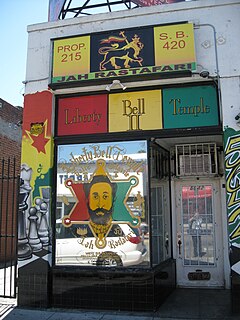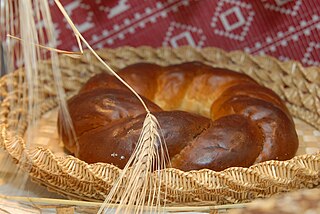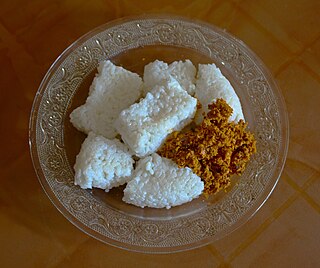 W
WÀkàrà (Hausa: kosai, Portuguese: Acarajé is a type of fritter made from cowpeas. It is found throughout West African, Caribbean, and Brazilian cuisines. The dish is traditionally encountered in Brazil's northeastern state of Bahia, especially in the city of Salvador. Acarajé serves as both a religious offering to the gods in the Candomblé religion and as street food. The dish was brought by enslaved peoples from West Africa, and can still be found in various forms in Nigeria, Ghana, Togo, Benin, Mali, Gambia and Sierra Leone.
 W
WBlack drink is a name for several kinds of ritual beverages brewed by Native Americans in the Southeastern United States. Traditional ceremonial people of the Yuchi, Caddo, Chickasaw, Cherokee, Choctaw, Muscogee and some other Indigenous peoples of the Southeastern Woodlands use the black drink in purification ceremonies. It was occasionally known as white drink because of the association of the color white with peace leaders in some Native cultures in the Southeast.
 W
WThe ortolan, also called ortolan bunting, is a bird in the bunting family Emberizidae, a passerine family now separated by most modern scholars from the finches, Fringillidae. The genus name Emberiza is from Old High German Embritz, a bunting. The specific hortulana is from the Italian name for this bird, ortolana. The English ortolan is derived from Middle French hortolan, "gardener".
 W
WDifferent religions have varying stances on the use of cannabis, historically and presently. In ancient history some religions used cannabis as an entheogen, particularly in the Indian subcontinent where the tradition continues on a more limited basis.
 W
WA česnica, also called Božićna pogača is the ceremonial, round loaf of bread that is an indispensable part of Christmas dinner in Serbian tradition. The preparation of this bread may be accompanied by various rules and rituals. A coin is often put into the dough during the kneading; other small objects may also be inserted. At the beginning of Christmas dinner, the česnica is rotated three times counterclockwise, before being broken among the family members. The person who finds the coin in his piece of the bread will supposedly be exceptionally lucky in the coming year. The česnica was used in folk magic for divining or influencing the amount of crops.
 W
WThe Dunvegan Cup is a wooden ceremonial cup, decorated with silver plates, which dates to 1493. It was created at the request of Caitríona, wife of John Maguire, lord of Fermanagh. The cup is an heirloom of the Macleods of Dunvegan, and is held at their seat of Dunvegan Castle. There are several traditions attributed to the cup, describing how the Macleods obtained it. However, it is thought more likely that the cup passed into the possession of the clan sometime in the 16th or 17th centuries. The Macleod chiefs have several other notable heirlooms kept at Dunvegan Castle, such as the Fairy Flag and Sir Rory Mor's Horn.
 W
WThe Eucharist is a Christian rite that is considered a sacrament in most churches, and as an ordinance in others. According to the New Testament, the rite was instituted by Jesus Christ during the Last Supper; giving his disciples bread and wine during a Passover meal, Jesus commanded his disciples to "do this in memory of me" while referring to the bread as "my body" and the cup of wine as "the new covenant in my blood". Through the eucharistic celebration Christians remember Christ's sacrifice of himself on the cross.
 W
WFirst Communion is a ceremony in some Christian traditions during which a person first receives the Eucharist. It is most common in many parts of the Latin Church tradition of the Catholic Church, Lutheran Church and Anglican Communion. In churches that celebrate First Communion, it typically occurs between the ages of seven and thirteen, often acting as a rite of passage. In other denominations, such as the Methodist Church in India, one's first communion ordinarily follows the reception of confirmation, which occurs after the age of ten; Eastern Orthodox and Oriental Orthodox Christians first receive the sacrament of Holy Communion in infancy, along with Holy Baptism and Chrismation.
 W
WHaft-sin or Haft-seen is an arrangement of seven symbolic items whose names start with the letter "س" pronounced as "seen" the 15th letter in the Persian alphabet; haft (هفت) is Persian for seven. It is traditionally displayed at Nowruz, the Iranian New Year, which is celebrated on the day of the vernal equinox, marking the beginning of spring on the Northern Hemisphere.
 W
WThe ʻava ceremony is one of the most important customs of the Samoa Islands. It is a solemn ritual in which a ceremonial beverage is shared to mark important occasions in Samoan society. The Samoan word ʻava is a cognate of the Polynesian word kava associated with the kava cultures in Oceania. Both terms are understood in Samoa.
 W
WIntinction is the Eucharistic practice of partly dipping the consecrated bread, or host, into the consecrated wine before consumption by the communicant.
 W
WKalach, kalács, kolach, kolač, or colac, is a traditional Eastern European bread, commonly served during various ritual meals. The name originates from the Old Slavonic word kolo (коло) meaning 'circle' or 'wheel'.
 W
WKava or kava kava is a crop of the Pacific Islands. The name kava is from Tongan and Marquesan, meaning 'bitter'; other names for kava include ʻawa (Hawaiʻi), ʻava (Samoa), yaqona or yagona (Fiji), sakau (Pohnpei), seka (Kosrae), and malok or malogu. Kava is consumed for its sedating effects throughout the Pacific Ocean cultures of Polynesia, including Hawaii, Vanuatu, Melanesia, and some parts of Micronesia, such as Palau. To a lesser extent, it is consumed in nations where it is exported as a herbal medicine.
 W
WKiribath is a traditional Sri Lankan dish made from rice. It is prepared by cooking rice with coconut milk, hence this name, and can be considered a form of rice cake or rice pudding. Kiribath is an essential dish in Sri Lankan cuisine. It is very commonly served for breakfast on the first day of each month and also has added significance of being eaten for any auspicious moment throughout one's lifetime which are marking times of transition. It is one of the more renowned traditional dishes in Sri Lanka.
 W
WKoliva, also spelled kollyva, kollyba or colivă, is a dish based on boiled wheat that is used liturgically in the Eastern Orthodox Church for commemorations of the dead.
 W
WLaba congee is a Chinese ceremonial congee dish eaten on the eighth day of the twelfth month in the Chinese calendar.
 W
WMakan bajamba is the traditional communal meals, shared from one container, and procession of dining on low tables set upon the floor; it is a tradition of the Minangkabau people that has existed since the founding of Islam and is conducted at ceremonial events, holidays, festivals, and important gatherings. Various of Minangkabau foods are served in the procession, which is carried in by female participants on their head. That foods are all laid out on metallic trays and then placed on the low tables and consumed while sitting on the floor. This procession opens with the performance of Minangkabau arts and begins with the recitation of traditional Minangkabau proverbs as well as proverbs from the Koran by elders and leaders. Literally, makan bajamba means eating together; it facilitates a sense of togetherness regardless of status of the participants.
 W
WQishr is a Yemeni traditional hot drink made of spiced coffee husks, ginger, and sometimes cinnamon. In Yemen, it is usually drunk instead of coffee because it doesn't need to be roasted.
 W
WThe Latin word refrigerium literally means "refreshment", and is the origin of the English noun "refrigerator". In ancient Rome, the word referred specifically to a commemorative meal for the dead consumed in a graveyard.
 W
WTangena is the indigenous name for the tree species Cerbera manghas of Madagascar, which produces seeds - containing the highly toxic cardiac glycoside cerberin - that were used historically on the island for trials by ordeal, held in order to determine the guilt or innocence of an accused party.
 W
WTarasari is a ball shaped sweet food consisting of sugar. It is especially used in Hinduism religious places for offering god. It is famous in Nepal.
 W
WA toast is a ritual in which a drink is taken as an expression of honor or goodwill. The term may be applied to the person or thing so honored, the drink taken, or the verbal expression accompanying the drink. Thus, a person could be "the toast of the evening" also known as a Toastmaster, for whom someone "proposes a toast" to congratulate and for whom a third person "toasts" in agreement. The ritual forms the basis of the literary and performance genre, of which Mark Twain's "To the Babies" is a well-known example.
 W
WTumpeng is an Indonesian cone-shaped rice dish with side dishes of vegetables and meat originating from Javanese cuisine of Indonesia. Traditionally featured in the slamatan ceremony, the rice is made by using a cone-shaped woven bamboo container. The rice itself may be plain steamed rice, uduk rice, or yellow rice.
 W
WWine is an alcoholic drink typically made from fermented grape juice. Yeast consumes the sugar in the grapes and converts it to ethanol, carbon dioxide, and heat. Different varieties of grapes and strains of yeasts produce different styles of wine. These variations result from the complex interactions between the biochemical development of the grape, the reactions involved in fermentation, the grape's growing environment (terroir), and the production process. Many countries enact legal appellations intended to define styles and qualities of wine. These typically restrict the geographical origin and permitted varieties of grapes, as well as other aspects of wine production. Wines not made from grapes involve fermentation of additional crops, including rice wine and other fruit wines such as plum, cherry, pomegranate, currant and elderberry.